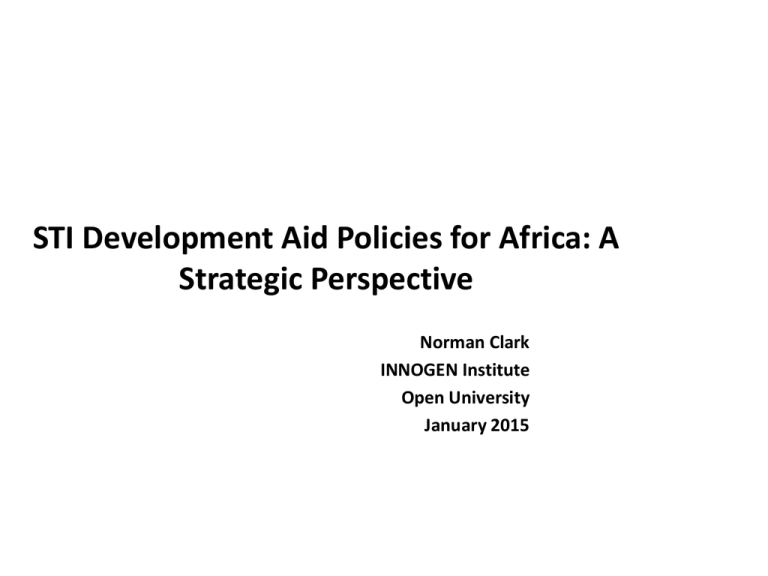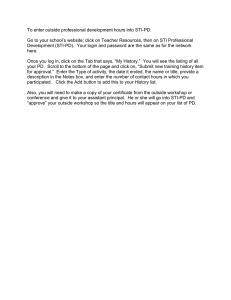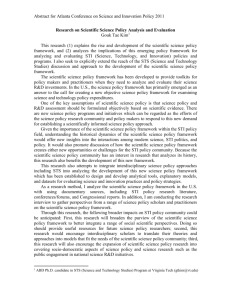The African Development Agenda and Strategic Priorities for Foreign Aid Post-2015: The Case for Aid for Science, Technology, Innovation and Sustainable Development
advertisement

STI Development Aid Policies for Africa: A Strategic Perspective Norman Clark INNOGEN Institute Open University January 2015 REFERENCES Pan-Africa • Mugabe J and Ambali A (2006) Africa’s Science and Technology Consolidated Plan of Action, NEPAD Office of Science and Technology, Johannesburg • African Union (2014) On the Wings of Innovation, Science, Technology and Innovation for Africa 2024 Strategy, STISA2024, April • NEPAD (2014) African Innovation Outlook II, ASTII, Pretoria, April National STI Plans • ESTA (Draft) National Science, Technology and Innovation (STI) Policy of Ethiopia 2006 • FMST National Policy on science, technology and innovation, 2012 (Nigeria) • ESTA Science, Technology And Innovation Policy 2012 Ethiopia Conclusions STI investments essential for sustainable development BUT 1. What kinds of investments? 2. In what types of bodies? 3. With what objectives? Institutional Challenges Strategic Issues for STI • Innovation (I) not identical with S/T • Integration of S/T with economic production: e.g. – – – – – Practical component of S/T degree programmes Re-introduction of national polytechnic programmes Phased programmes of tertiary education Policies established and owned by host governments Specific orientation towards employment Supportive Foreign Assistance [with substantive backstopping] Case Study: DFID’s Research into Use Programme (RIU) • • • • • DFID’s concerns about its research funding for natural resources research RNRRS 1600 research projects (£220m) 10 programmes 1995-2005 Problem no apparent use Structural issue on knowledge and technology development [VFM] • RIU £37.5 million SSA & S Asia (2006-12) [Output/Learning] Research into Use (RIU) • Aid programme with learning aspect (STI policy) • Large complex one, many people involved and comprising many subprogrammes and projects • Experimental and began with a strong “supply push” character (scale out of 30 projects) • “Innovation systems” approach • Has used concepts such as “innovation platforms”, “value chains” • Poverty and gender focus RNRRS Programmes • • • • • • • • • • Animal Health Livestock Production Aquaculture and Fish Genetic Research Crop Post-harvest Crop Protection Fisheries Post-harvest Fisheries Forestry Research Natural Resources Systems Plant Sciences RIU Inception • • • • • • • • Put out to tender (£37.5 million) Four short-listed consortia Selection of NR International Ltd Mid term review (2008/2009) Shift to RIR Ltd (Edinburgh University) Extension to December 2012 Simplified programme Greater local autonomy AFRICA Country programmes ASIA Research projects BEST BETS Promising technologies OUTPUT 1: PROMOTION OF EXISTING KNOWLEDGE I4D FUND Financing entrepreneurs Output 2 Learning • Researchers • Working with projects • Capacity building RIU Component Activities[SSA] • • • • • • • Country assessments (diagnostic) Innovation coalitions (stakeholders) Country strategies Innovation platforms (product-based) Tech/econ constraints Project funding M&E Best Bets Programme (09-12) • Mobilise private sector resources in consortia that would demonstrate RIU sustainability (exit strategy) • Initially asked for a 2 page outline concept note • Screening of concept notes (CEPA) • Selection of short list • Writing of business plan ($2,500) • “Dragon’s Den” Panel (11/09) Concept Notes (2 pages) • • • • • • RNRRS research Scientist involvement Impact at Scale African led Consortia Private sector partner Private sector resource input Selection Process • 125 applications ; Short list of 15 (9 chosen) • “Dragons Den” event (November 2009) • “Training” of applicants • Decision and issuing of contracts (end of year) • Total budget £5 million Dragons Den Panel • Judi Wakhungu, Geophysicist, ACTS ED (K) • Patrick Oketa, CIO African Agricultural Capital (Ug) • Muchiri Wahome (Chair) MD of Deacons (K) Ltd. (retail chain) • Ali A Mufuruki, Chairman and CEO of the Infotech Investment Group (Tz) Ultimate Aim To generate knowledge about how best to put research into use in a sustainable way Important role of the private sector hence use of the “dragons den” Projects 1. 2. 3. 4. 5. 6. 7. 8. 9. Armyworm forecasting and elimination (K & Tz) Biocides ( Kenya) Biocides (Ghana) Aquaculture (Kenya) Seed Yam (Nigeria) NERICA Rice (Uganda) Farm Inputs (K & Tz) “Shujaaz” Comic (Kenya) Sleeping Sickness (Uganda) Example FIPS • Small packs • Agronomy (fertiliser) • Village-based advisers (VBAs) cascade process • • • • Total technology model Fertiliser companies Impacts Other/market access Some Preliminary Conclusions Science Input • Complexity of projects (range of necessary agents) • “applied engineering” rather than “science” mentoring role • RNRRS used “ex post” [but not “ex ante”] 61 used but initially none suitable for scale out (demand pull) • Networked systems in all cases • Necessity of a lead champion • Problems soliciting projects [most bids research-driven] Some Preliminary Conclusions 2 [Economic Impacts] • Productive facilities created New extension businesses (e.g. FIPS VBAs) Agro-dealers New outlets for established business Other businesses • Venture capital interest (3 from 9) • Need for capacity building Some Preliminary Conclusions 3 [Wider Impacts] •Tertiary education institutions mobilised 17 TE bodies used to provide inputs •Impacts on the wider aid context e.g. BMGF USAID CGIAR (IITA, WARDA) •Role of national governance (e.g. extension and regulation) Foreign Aid as pre-competitive subsidy Policy Agenda Inefficient “knowledge market” Policy question How better to finance technology development aid to maximise “value for money”? Conclusions STI investments essential for sustainable development BUT 1. What kinds of investments? 2. In what types of bodies? 3. With what objectives? Institutional Challenges Strategic Issues for STI • Innovation (I) not identical with S/T • Integration of S/T with economic production: e.g. – – – – – Practical component of S/T degree programmes Re-introduction of national polytechnic programmes Phased programmes of tertiary education Policies established and owned by host governments Specific orientation towards employment Supportive Foreign Assistance [with substantive backstopping] Africa STI Approach • Excessive emphasis on scientific research as the leading metaphor • Incomplete understanding of innovation • Relative neglect of issues associated with economic development (production, employment, youth, incomes) • Need to re-visit and revise regional and national policy dialogue Associated Role for ACTS Other References 1. Gildemacher & Mur Bringing new Ideas into Practice, KIT Amsterdam 2. DFID Research into Use: An Independent evaluation 3. A Hall et al RIU Discussion Paper Series (27) www.researchintouse .com Questions/Comments





